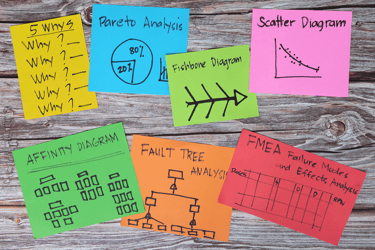The Packaging Industry's Sustainability Challenge: Why ERP Systems Are Essential for Success A straightforward guide to navigating sustainability regulations across folding carton, flexible...
The Power of Data: Unlocking Packaging Automation & Smart Manufacturing
The fourth industrial revolution is said to be Industry 4.0. It has changed (and promises to change) manufacturing.
The impetus is simple: how can I do more with less? How can businesses move towards a more intelligent and automated operation? How can companies increase revenue, reduce the cost of goods sold (COGS), and comply more with sustainability regulations?
By integrating new technologies, such as the Internet of Things (IoT), cloud computing, machine learning, and Artificial Intelligence (AI), packaging and corrugated companies are searching to transform their shop floor into a smart factory. But you must ask yourself: is my business ready to adopt such a robust tech stack?
In this blog post, we’ll explore how high-quality, real-time, and verifiable data unlocks advanced packaging automation and drives Industry 4.0 initiatives forward, including how AI and ML techniques such as classification and regression can be leveraged to turn raw data into actionable insights.
Contents
- Identify and Collect Your Key Data Points
- Taking Data to the Next Level: Advanced Packaging Automation and Actionable Insights
- With data Comes Actionable Insights
- What Areas of Packaging Manufacturing can be Improved with Advanced Packaging Automation?
- How can eProductivity Software help you Future-Proof your Business with Data?
Identify and Collect Your Key Data Points
Data fuels decision-making and process optimization in the packaging and corrugated industries. Real-time, reliable data is required to swiftly respond to requests for quotations (RFQs), track raw materials and inventory, minimize waste, optimize machine utilization, and dynamically schedule jobs.
Here are some key data points you should constantly monitor to start making smarter decisions:
- Material Requirements: Understanding costs, managing inventory, and ensuring visibility across the supply chain.
- Labor Data: Tracking workforce productivity and performance.
- Machine Metrics: Monitoring speed, capacity, downtime, availability, and maintenance needs.
- Job and Order Statuses: Keeping tabs on the progress of each task and order in the production pipeline.
- Traceability Details: Maintaining records to comply with quality standards and regulations.
- Supply Chain Management Insights: Ensuring seamless coordination with suppliers and distributors.
- Cost Data: Analyzing expenses to identify areas for improvement and cost-saving opportunities.
Once you have identified and collected those data points, you can start analyzing which areas of your business need improvement. For example, if machine downtime has increased, data will tell you if that was triggered by a shortage in raw materials or even unscheduled maintenance - or it could be both! Only data will tell you.
Those data points will also allow you to set your SMART (Specific, Measurable, Achievable, Relevant, and Time-Bound) goals. Using the previous examples, you can set goals to reduce machine downtime by 15% in the next 12 months.
The fun part begins when you ask yourself how to achieve that goal.
By looking at the data, you can understand what actions you need to take to complete that specific goal. Even more, by leveraging state-of-the-art technology, like industry-specific ERP software for packaging, like Radius ERP, or shop floor data collection systems, such as Auto-Count 4D, you can automate your workflows and quickly move from a reactive approach to a proactive one.
Data flowing back and forth from the shop floor to your packaging ERP can unlock automation by setting parameters to avoid machine downtime, such as predictive maintenance, inventory alerts, and more! But we’ll dive into it later.
Taking Data to the Next Level: Advanced Packaging Automation and Actionable Insights
The fourth industrial revolution, or Industry 4.0, is all about smart factories and machines. Companies are looking for ways to increase productivity and efficiency through automation. And what drives this industrial revolution is data. As data flows from all business areas, companies can make more informed decisions in search of growth and sustainability.
Let’s set an example.
One of the biggest struggles in the packaging industry is scheduling. How can you increase throughput and minimize manual touchpoints to complete more jobs faster without additional costs?
By looking at data from the shop floor (machines, raw material availability, operators, etc), it is possible to identify bottlenecks in production due to material shortage and increased machine downtime, for example.
Powered by real-time data, packaging automation can create a rule-based scheduling production plan and transfer company knowledge into business rules, allowing automatic load balancing, switchover optimization, and synchronization. The goal is to improve scheduling’s ability to increase throughput and profitability. It is what Industry 4.0 and automation are all about.
This is just one example of how data can fuel advanced packaging automation in scheduling. But automation can impact every aspect of your operation.
Let's examine how other ways you can revolutionize your packaging operations by working smarter, not harder.
Customer Service Enhancement
By harnessing data, including costs, jobs, raw materials, and shipping, businesses can respond faster to customer queries, generate more accurate RFQs, and streamline sales order entry processes. With access to comprehensive data, customer service representatives can provide real-time updates on order status and delivery schedules, enhancing overall customer satisfaction.
Accurate Estimates and Job Planning
Leveraging existing data allows for speedy and precise order inputting, visibility into stock levels to avoid over-production, and improved customer service through transparent order tracking. Advanced algorithms can analyze historical data to generate accurate estimates for material requirements, production timelines, and job costs, enabling better-informed decision-making and more efficient resource allocation.
Stock and Purchasing Optimization
A clear picture of stock status minimizes the risk of over-purchasing materials while tracking material usage helps identify unused stock, reducing waste. By integrating real-time data from inventory management systems with purchasing forecasts and production schedules, businesses can optimize procurement processes, minimize stockouts, and reduce carrying costs.
Advanced Automation for Packaging Scheduling
Businesses can use advanced automation by adopting real-time data integration across departments. This approach optimizes production plans, maximizes capacity, increases throughput, and enhances equipment utilization. By leveraging real-time data on machine availability, job order priorities, and resource constraints, scheduling algorithms can dynamically adjust production schedules to minimize idle time and maximize efficiency, just like the above example.
Real-Time Shop Floor Data Collection
Operators equipped with comprehensive real-time job information can optimize performance in real-time, while supervisors gain visibility into shop floor operations for better resource allocation and performance monitoring. Businesses can identify bottlenecks, streamline workflows, and improve efficiency by capturing data on machine performance, operator productivity, and job progress.
With data Comes Actionable Insights
Actionable insights are conclusions and actions that come after data collection and analysis.
Packaging businesses can turn data into actionable insights by harnessing data from various sources, such as raw material inventory, supply chain information, job and machine status, and customer feedback. Once areas for optimization are identified, businesses can make strategic adjustments to improve performance and efficiency.
Very soon, cutting-edge technological models, such as advanced automation, machine learning, and even artificial intelligence, will be able to create real-time actionable insights from processing data collected across all business areas.
What Areas of Packaging Manufacturing Can Be Improved with Advanced Packaging Automation?
Streamlining processes and ensuring impeccable data quality are vital preparatory measures for businesses for a complete automated operation. Industry 4.0 technologies excel at analyzing extensive datasets to detect patterns, optimize processes, and make proactive recommendations for continuous improvement.
These are three examples of where your packaging business can profit from advanced automation and other Industry 4.0 technology:
- Enhanced Quality Control and Inspection: Technologies enable advanced Quality Control (QC) and inspection processes in packaging manufacturing. Data-powered systems, such as Escada Automatic Corrugator Warp Control, can detect defects, inconsistencies, and deviations from quality standards more accurately and efficiently than traditional or manual methods.
Manufacturers can quickly identify defects by leveraging computer vision, machine learning, and data analytics to reduce waste and ensure product quality and consistency. - Predictive Maintenance and Optimization: Predictive maintenance solutions transform packaging operations by proactively identifying equipment failures and performance issues before they occur. Advanced algorithms predict maintenance needs, schedule downtime efficiently, and optimize equipment performance by analyzing data from sensors, machines, and production processes, as featured in Escada Reliability.
This proactive approach minimizes unplanned downtime, reduces maintenance costs, and maximizes Overall Equipment Effectiveness (OEE), increasing productivity and profitability. - Supply Chain Optimization and Demand Forecasting: Advanced algorithms can generate accurate demand forecasts, optimize inventory levels, and improve supply chain efficiency by analyzing vast amounts of data from various sources, including sales data, market trends, weather patterns, and supplier information. With AI-driven insights, packaging businesses can anticipate changes in demand, adjust production schedules accordingly, minimize stockouts and excess inventory, and enhance overall supply chain resilience and agility.
How can eProductivity Software help you Future-Proof your Business with Data?
Access to real-time, high-quality data is paramount to pushing continual improvement and success in packaging businesses. Collecting and analyzing this data enables informed decision-making, constituting the cornerstone of actionable insights.
Fundamentally, the successful implementation of any model depends on meticulous data collection and analysis across crucial areas such as material requirements, workforce productivity, machine efficiency, and supply chain dynamics.
ePS Packaging is an indispensable partner for packaging and corrugated businesses. It delivers tailor-made ERP and MES solutions that drive efficiency, reduce costs, and future-proof operations through continuous innovation and user-centric design.
By offering comprehensive end-to-end solutions tailored specifically for this sector, we provide companies with the tools to embark on their digital transformation journey towards intelligent manufacturing processes and advanced automation.



